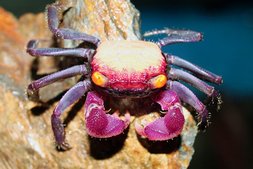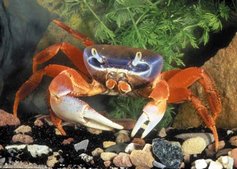Freshwater Crayfishes

There are around 500 species of freshwater crayfishes worldwide, with the majority of these species being found in North America and Australia. There are a number of species of aquarium importance: North American species of Cambarus and Procambarus, Central American species of Cambarellus, and species of Cherax from Australia and New Guinea. In addition the native European species Astacus astacus is sold for garden ponds.
Important requirements
Crayfishes are omnivores that are active at twilight and during the night. None of them is truly social in its behaviour, but the species usually seen in the aquarium hobby are normally relatively tolerant of their own kind. Good daytime hiding-places are particularly important for these crays. Each individual maintained in the aquarium should have its own personal hiding-place in the form of the narrowest possible cave. The ideal cave size is one into which the occupant can only just fit.
All crayfishes are extremely sensitive to metals in the water, with copper in particular being exceptionally toxic for crustaceans. This should be borne in mind, particularly where there are new copper water pipes in use. That aside, they have no particular requirements regarding the water, although in some species the hardness of the water has a direct effect on the coloration of the shell. The pH should not be significantly lower than 6 and no higher than 9.
For long-term maintenance it is important for the aquarium to contain fine gravel in a variety of grain sizes, as the crayfishes need to ingest pieces of gravel for their organ of balance after every moult.
In general crayfishes are better adapted to low water temperatures than to high. No species requires special heating; the temperature tolerance of the usual aquarium crays is between 10 and 28 °C.
Appropriate feeding
Crayfishes are omnivores that feed mainly on dead organic material of all types, and they will also feed opportunistically on any food available. In the aquarium they may also prey on sleeping fishes and consume living aquatic plants.
The basic diet of all aquarium crays should be the dead leaves of native European trees. All non-toxic tree leaves are suitable, but fruit tree leaves (particularly cherry) are particularly enjoyed, along with Maple, Birch, Beech, Chestnut, Walnut, Oak, and Alder. It is very important to use dry brown autumn leaves. Unlimited amounts of these leaves should be freely available in the aquarium as the basic food, and the mixture should always include Oak, which simultaneously acts as a prophylactic against disease. In addition green leaves can be picked and dried and used for food, but will pollute the aquarium badly because of their high sugar content and lead to a high germ count in the water. Hence they should be used only for special reasons such as therapeutic purposes.
In addition all types of dry and frozen foods intended for ornamental fishes can be used as titbits or for variety, as long as they sink to the bottom, as crayfishes feed almost exclusively on the bottom.
Correct maintenance
As with ornamental fishes, regular partial water changes are the most important element of maintenance. The amount depends on the population of the aquarium: up to a third of tank volume weekly in heavily populated aquaria, but in tanks with a low population density and efficient biological filtration this can be reduced to 20% of tank volume every 14 days. The new water should be conditioned, and if possible no more than 3-4 °C different from the aquarium water in temperature. The new water can be somewhat cooler, but never warmer than the aquarium water.
Aquarium and tankmates
Crayfishes are not especially active and hence don’t require a lot space. The minimum bottom area of the aquarium should be about five times the length of the crays by two to three times. The height of the aquarium is unimportant, as these crays remain almost exclusively on the bottom. If several individuals are to be kept then the aquarium size must be adjusted accordingly.
Almost all crays are inclined to cannibalism. They also need to moult their external skeleton in order to grow. After moulting they remain very soft and vulnerable for several hours to days. Hence suitably-sized caves are essential for their survival after moulting, so that they can’t be eaten by their fellow crays.
Life expectancy
Life expectancy is largely dependent on water temperature, and for most species is around three to four years, rarely up to eight, in the domestic aquarium.
Astacus astacus, the native European river crayfish, can live for up to 20 years if maintained in near-natural conditions.
Size
The species maintained in the aquarium vary from 3 cm (dwarf river crays, Cambarellus) to 20-30 cm (Cherax destructor). Even the largest species are sexually mature by the second year of life, and the majority of species require less than a year to attain roughly their eventual size.
Special details
The majority of crayfish species can theoretically survive in the wild in many European countries. This is a great pity, as without becoming sick themselves they can be carriers of a disease that is fatal to all native European crays. Unfortunately the unthinking release of foreign crayfishes has already caused serious harm. Hence under no circumstances whatsoever should surplus individuals be released into the wild. They an be used as animal food (zoos generally have animals that enjoy eating crays), and you can even eat them yourself once they have reached a certain size. Anyone planning to keep crayfishes in the garden pond must bear in mind that these creatures can cover large distances over land during rainy days or nights. Hence the garden pond (or the garden in which it is situated) must always be completely escape-proof for wildlife conservation reasons.



















